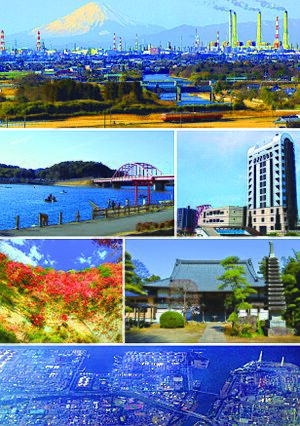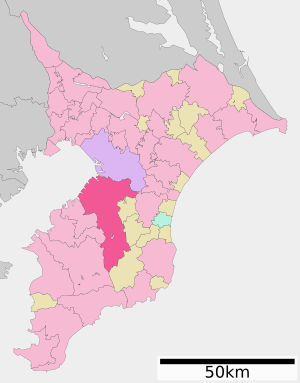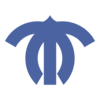Ichihara, Chiba facts for kids
Quick facts for kids
Ichihara
市原市
|
|||||||||||||
|---|---|---|---|---|---|---|---|---|---|---|---|---|---|

|
|||||||||||||
|
|||||||||||||

Location of Ichihara in Chiba Prefecture
|
|||||||||||||
| Country | Japan | ||||||||||||
| Region | Kantō | ||||||||||||
| Prefecture | Chiba | ||||||||||||
| First official recorded | mid 3rd century (official) | ||||||||||||
| Goi town settled | May 20, 1891 | ||||||||||||
| Ichihara town settled | March 31, 1955 | ||||||||||||
| Both town merged and city settled | May 1, 1963 | ||||||||||||
| Area | |||||||||||||
| • Total | 368.17 km2 (142.15 sq mi) | ||||||||||||
| Population
(December 1, 2020)
|
|||||||||||||
| • Total | 274,117 | ||||||||||||
| • Density | 744.539/km2 (1,928.348/sq mi) | ||||||||||||
| Time zone | UTC+9 (Japan Standard Time) | ||||||||||||
| Phone number | 0436-22-1111 | ||||||||||||
| Address | 1-1-1 Kokubunjidai Chūō, Ichihara-shi, Chiba-ken 290-8501 | ||||||||||||
| Climate | Cfa | ||||||||||||
|
|||||||||||||
Ichihara (市原市 (Ichihara-shi)) is a city located in Chiba Prefecture, Japan. As of December 2020, about 274,117 people lived in Ichihara. The city covers an area of about 368 square kilometers (142 square miles).
Ichihara is a big part of the Greater Tokyo Area. It is also home to the JEF United football (soccer) club, which it shares with the city of Chiba.
Contents
Exploring Ichihara's Geography
Ichihara is found in the western part of the Bōsō Peninsula. It is the largest city in Chiba Prefecture by land area. The southern part of the city has mountains and hills.
The northern part of Ichihara is very industrial. It faces Tokyo Bay. Many people live in Ichihara, and it acts as a "satellite town" for Tokyo and Chiba City. This means many residents work or study in those bigger cities.
Neighboring Cities and Towns
Ichihara shares its borders with several other places in Chiba Prefecture:
Ichihara's Climate
Ichihara has a humid subtropical climate. This means it has warm summers and cool winters. There is usually little to no snowfall. The average temperature each year is about 15.1 degrees Celsius (59.2°F).
The city gets a lot of rain, about 1673 millimeters (65.9 inches) per year. October is usually the wettest month. August is the warmest month, with temperatures around 26.5 degrees Celsius (79.7°F). January is the coldest, at about 4.1 degrees Celsius (39.4°F).
A Look at Ichihara's History
The area where Ichihara is today was once the center of an ancient Japanese province called Kazusa province. Archeologists have found the ruins of the Nara period Kazusa Kokubun-ji temple here. This was a very important provincial temple.
During the Sengoku period (a time of civil wars in Japan), different powerful families fought over this area. These included the Chiba clan and the Satomi clan. Later, during the Edo period, the land was split into different areas. Some parts were controlled by local lords, and others were directly managed by the main Japanese government.
Important Dates in Ichihara's History
- In the Meiji period, around the late 1800s, the area was organized into many small villages.
- In September 1923, a very strong earthquake, the Great Kanto earthquake, affected the city.
- By 1945, many of these small villages had joined together to form five towns and 16 villages.
- The modern city of Ichihara was officially created on May 1, 1963, by merging several towns and villages.
- On October 1, 1967, the town of Nansō and the village of Kamo became part of Ichihara.
- On March 11, 2011, a powerful earthquake and tsunami hit Japan. This caused a fire at an oil refinery in Ichihara.
Ichihara's Population Over Time
The number of people living in Ichihara grew a lot for many decades. Recently, the population has stayed about the same.
| Historical population | ||
|---|---|---|
| Year | Pop. | ±% |
| 1920 | 68,825 | — |
| 1930 | 71,287 | +3.6% |
| 1940 | 75,069 | +5.3% |
| 1950 | 98,375 | +31.0% |
| 1960 | 94,309 | −4.1% |
| 1970 | 155,852 | +65.3% |
| 1980 | 216,394 | +38.8% |
| 1990 | 257,716 | +19.1% |
| 2000 | 278,218 | +8.0% |
| 2010 | 280,416 | +0.8% |
| 2020 | 269,524 | −3.9% |
Economy and Industry
Ichihara's economy is strong because of its large industrial area. This area is located along Tokyo Bay. The city has many oil refineries, more than any other place in Japan.
It also has companies that produce power, make petrochemicals (chemicals from oil and gas), and build ships. These industries provide many jobs and help the city's economy grow.
Education in Ichihara
Ichihara has many schools for young people. The city government runs 41 public elementary schools and 21 public middle schools. The Chiba Prefectural Board of Education operates six public high schools.
There is also one private elementary school and two private high schools. For students with special needs, the prefecture runs one special education school. Ichihara is also home to Teikyo Heisei University.
Getting Around Ichihara: Transportation
Ichihara has a good transportation system, including railways and highways.
Railway Lines
Several train lines serve Ichihara, making it easy to travel.
 JR East – Uchibō Line
JR East – Uchibō Line
- Yawatajuku - Goi - Anegasaki
 Keisei Electric Railway – Keisei Chihara Line
Keisei Electric Railway – Keisei Chihara Line
- Chiharadai
 Kominato Railway – Kominato Line
Kominato Railway – Kominato Line
- Goi - Kazusa-Murakami - Amaariki - Kazusa-Mitsumata - Kazusa-Yamada - Kōfūdai - Umatate - Kazusa-Ushiku - Kazusa-Kawama - Kazusa-Tsurumai - Kazusa-Kubo - Takataki - Satomi - Itabu - Tsukizaki - Kazusa-Ōkubo - Yōrōkeikoku
Major Highways
Highways connect Ichihara to other parts of Japan.
 Ken-Ō Expressway
Ken-Ō Expressway Tateyama Expressway
Tateyama Expressway National Route 16
National Route 16 National Route 297
National Route 297 National Route 409
National Route 409
Sister City
Ichihara has a special connection with another city far away.
 Mobile, Alabama, United States, since November 10, 1993. This means they are "sister cities" and share cultural and educational exchanges.
Mobile, Alabama, United States, since November 10, 1993. This means they are "sister cities" and share cultural and educational exchanges.
Famous People from Ichihara
Many talented people come from Ichihara, including:
- Chiaki, a singer
- Neko Hiroshi, a marathon runner
- Katsushige Kawashima, a boxer
- Hirotoshi Ishii, a baseball player
- Kohei Kudo, a soccer player
- Suzuran Yamauchi, a TV personality (tarento)
See also
 In Spanish: Ichihara (Chiba) para niños
In Spanish: Ichihara (Chiba) para niños





